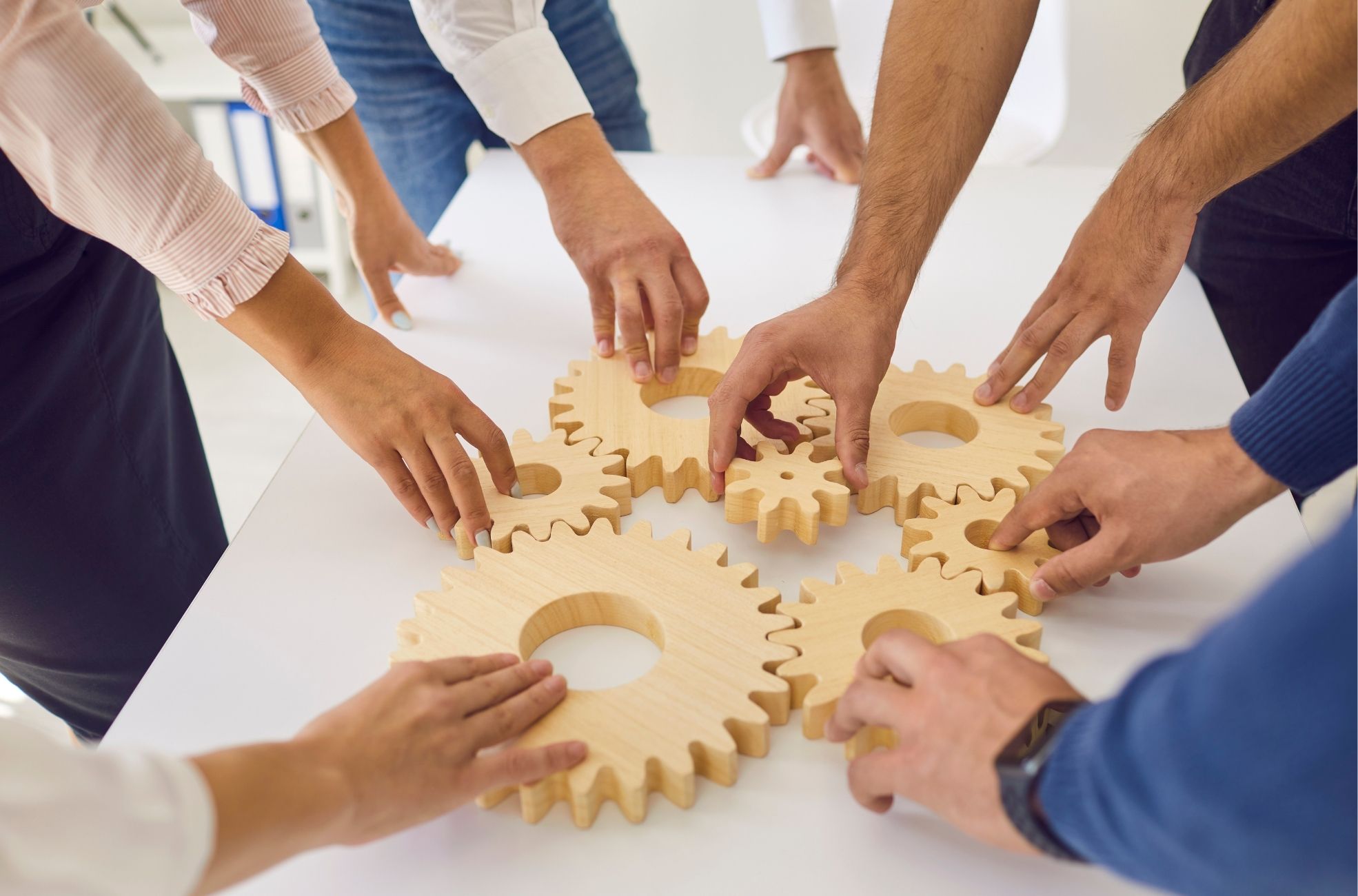Are you looking to foster communication, trust, and collaboration within your team? Want to boost productivity in your workplace through innovative team-building activities? Well, you’re in the right place! This comprehensive piece is your go-to for valuable insights on team-building activities to reinforce unity, spark creativity, and combine individual strengths for collective success.
Tailored to your corporate team-building needs, this article will guide you in identifying your goals, carrying out engaging activities, evaluating their impact, and more. Let’s get started and empower your team with activities that actually work, fostering a more positive, productive work environment.
Understanding Corporate Team Building Activities
Corporate team-building activities play a key role in shaping a cohesive, productive team. They’re designed to encourage communication, planning, problem-solving, and conflict-resolution skills. They offer a platform for you and your colleagues to learn about each other’s strengths, weaknesses, and interests, which can lead to improved collaboration on future projects.
Why Corporate Team Building Is Essential
Team building boosts employee motivation and collaboration in businesses and organisations. It’s not just about fun; it’s about creating a team that works together towards a common goal. This process can enhance workplace projects that involve teamwork and boost productivity through healthy competition.
Moreover, team-building activities can enrich company culture by providing a space to learn about employees’ wants and needs. Regular team-building events can enhance the work environment and create a more positive atmosphere. These activities give employees something to look forward to, breaking up the work routine and providing a shared goal outside of work-related tasks.
The Science Behind Team Building
Research shows that teams with higher levels of communication among members outperform other teams in almost every metric measured. That’s why strategic team building activities that promote communication are the most effective way to nurture a corporate culture where growth and development are valued.
Studies also reveal that trust is a key element in team building. Trust encourages creativity and innovation by creating a safe space for sharing ideas. Effective team-building activities should focus on building interpersonal relationships and enhancing problem-solving abilities.

Identifying Goals for Your Team-Building Activities
Setting goals is a key part of team building. It helps you and your colleagues track performance, review development progress, and suggest any further training or education that may aid these goals. Goal-setting activities can boost employee engagement, participation, motivation, and skill-building.
Various goal-setting activities can be used, such as backward goal-setting, where participants start with a large objective and gradually scale it down. Other activities include the “if you win $20 million” activity, which helps participants identify and prioritise their core values and priorities, and the “accomplishments vs. long-term objectives” activity, which shows the impact of using minor objectives to reach a larger goal.
Other Benefits of Team Building Activities
Team building activities offer numerous benefits beyond improving communication and fostering trust. They can help unlock leadership potential by providing a relaxed and creative environment where hidden skills can be discovered. Regular team-building events can boost employees’ confidence in the workplace and identify potential leaders.
These activities can also build bridges across departments, encouraging cross-functional collaboration and creating a more unified organisation. They can help retain current talent and attract new talent, creating a positive reputation for the company.
Moreover, team-building activities can boost employee engagement and morale. They build camaraderie, excite employees to come to work, and encourage them to step away from their desks and have fun.
Team building activities are key to creating a successful, productive team. They foster communication, trust, and collaboration, and they can help identify and achieve team goals. Businesses and organisations can create a more positive, productive work environment by recognising the importance and benefits of team-building activities.
Types of Corporate Team Building Activities
Outdoor Activities
Outdoor team-building exercises are an excellent method to foster unity and a sense of belonging among your team members. Options range from scavenger hunts, field days, walking tours, and photo challenges to more adventurous pursuits like rope courses, paintball, and relay races. These activities can be tailored to your team’s unique needs and preferences, enhancing teamwork, communication, problem-solving, and leadership abilities.
For instance, scavenger hunts, whether self-guided or app-led, stimulate exploration and interaction. Boat building challenges, where teams construct cardboard boats and sail them across a pool, promote cooperation and problem-solving. Hiking allows your employees to connect with nature, build physical strength, and explore new locations.
More relaxed outdoor activities like dish parties, BBQ potlucks, or a simple running club can also benefit. These activities provide a break and a chance for interaction and solidify relationships, which can enhance workplace efficiency.
Indoor Team Building Games
Indoor team-building exercises are another effective method to enhance your team’s motivation, collaboration, engagement, and morale. These activities can be conducted at any time, regardless of the weather, making them a reliable choice.
Trivia games can be fun to test your team’s knowledge and stimulate friendly competition. Problem-solving activities like the Lucky Penny game can stimulate creative thinking and cooperative problem-solving. Storytelling exercises, like the Favourite Memory Wall, can help your team members bond and get to know each other better.
Volunteer or Community Service Activities
Volunteering and community service exercises are also excellent team-building options. They allow your teams to contribute to the community while bonding and working together. These activities range from tree planting, beach or neighbourhood cleanups, making and giving care packages, and charity runs/walks. These activities foster a sense of community, enhance company culture, and allow your teams to create rewarding memories.
Training Workshops and Seminars
Training workshops and seminars are another effective method to foster team spirit. They can be conducted outdoors or indoors, providing employees a more relaxed and interactive learning environment. These activities can be tailored to your team’s specific needs, focusing on areas such as communication, problem-solving, leadership, or any other relevant topic. The key is to ensure that these workshops and seminars align with your team’s and organisation’s goals and objectives.
Planning and Executing Corporate Team Building Activities
Taking the First Step: Idea Generation
The initial phase in orchestrating a successful team-building event is brainstorming. Well-defined objectives and targets should steer this process for the occasion. It’s vital to take into account the unique requirements and inclinations of your workforce, as well as the potential for individual and career advancement. For instance, exercises pushing participants to venture beyond their usual boundaries can result in personal development and fortified colleague relationships. Likewise, integrating a community service element can instil a sense of purpose and significance.
Logistical Planning: Venue, Time, and Budget Considerations
With a well-defined concept of your objectives, you can move on to logistical planning. This involves allocating funds, selecting a location, and determining a date and time for the occasion. When allocating funds, it’s crucial to be pragmatic and allow some leeway for unforeseen costs.
Selecting a location requires thoughtful evaluation of several aspects, including expense, guest count, location, theme, facilities, and availability. The location should be easily reachable for all team members and offer the necessary facilities and conveniences for the planned exercises.
When determining a date and time, consider employees’ schedules and personal commitments to ensure maximum attendance. Keep in mind the success of a team-building event is greatly influenced by the location and timing.
Practical Execution and Guidance during the Event
With all the planning complete, it’s time for the practical implementation of the event. This involves formulating a clear agenda and timetable for the day, which should include specifics such as arrival time at the location, the commencement time of the exercise, and meeting points.
During the occasion, offering guidance and support is crucial to ensure a smooth flow. This might involve motivating participants to partake in the exercises, assisting those who may require additional help, and ensuring that the occasion is enjoyable and captivating for everyone.
Ensuring Active Participation and Engagement
Securing active participation and engagement is a vital part of any team-building event. This can be achieved by promoting the event beforehand through various channels, such as email, company website, internal forums, and social media.
During the occasion, exercises should be designed to foster communication, collaboration, and teamwork. A touch of friendly rivalry can enhance enjoyment and engagement, while inventive activities can foster innovation and creativity.
After the occasion, gathering participant feedback is crucial to assess the event’s success and pinpoint areas for enhancement. This can be done through surveys, attendance and participation statistics, and monitoring productivity and morale.
Evaluating the Success of Team Building Activities
Assessing the effectiveness of team-building activities is crucial in ensuring these exercises benefit your team. This involves obtaining feedback, gauging the impact on team performance, identifying success indicators, and refining future activities.
Gathering Post-Activity Feedback
Collecting feedback from your team members post-activity is vital. This can be achieved through various methods such as surveys, polls, interviews, focus groups, and observation. Surveys and polls provide quantitative data, while interviews and focus groups yield qualitative data. Observation helps assess behaviour and engagement during the activity.
When formulating questions for your team, ensure they’re clear, relevant, and specific to the goals and outcomes of the activity. A balance of open-ended and closed-ended questions can provide a mix of quantitative and qualitative data.
Measuring the Impact on Team Performance
To gauge the impact of team building activities on team performance, compare baseline metrics pre and post-activity. This could include monitoring and evaluating metrics like absentee rates, productivity rates, profit, and overtime. Another way to gauge the effectiveness of team building activities is to observe the positive energy and boost in productivity immediately after the activity. You can then monitor the sustainability and productivity of the team in the weeks and months following the activity.
Indicators of a Successful Team-Building Activity
Successful and productive teams share certain social characteristics like equal participation, clear and energetic contributions, multi-directional communication, engaged body language, and face-to-face collaboration. These can be nurtured through team-building activities.
Making Improvements for Future Activities
Once you’ve gathered and analysed feedback, acting on it and using it to improve future team-building activities is important. This involves addressing any issues or concerns that the team may have and designing better activities based on the feedback. It’s also beneficial to share the feedback with the team and thank them for their participation and input.
Creating a culture of feedback and collaboration through team-building activities encourages open communication and continuous improvement. This, in turn, fosters a positive work culture and improves team performance.

Case Studies of Effective Corporate Team Building Activities
Let’s explore real-world examples across various sectors to understand how they leverage team building.
Tech Companies’ Approach to Team Building
In the tech sector, companies are often pioneers in adopting contemporary team-building practices. For instance, during the COVID-19 pandemic, Microsoft’s Azure team participated in a virtual team-building event facilitated by Outback Team Building & Training. This activity served to reconnect and re-engage their remote team, demonstrating the effectiveness of virtual team-building events in fostering team unity and engagement.
Likewise, MyZone, a company with remote employees, also engaged Outback Team Building & Training for a virtual team building event to bring their employees closer together during the pandemic. These instances underscore the importance of aligning team-building activities with your team’s objectives and preferences, even in challenging circumstances.
How Retail Industry Encourages Employee Teamwork
In the retail sector, team-building activities often aim to enhance communication, identify team leaders, and foster a positive working environment. For instance, IBM engaged Wildgoose Events for a customised team-building activity to welcome new employees, facilitate ice-breaking, explore the city, and familiarise them with the company’s culture. This activity facilitated the integration of new employees into the team and fostered a sense of community within the company.
Moreover, retail brands need to adapt to the growth of online shopping by providing unique and personalised experiences in their physical stores. High-performing teams in retail can significantly influence customer satisfaction, brand loyalty, and overall success. These teams actively work towards the same objectives and deliver innovative and superior results.
Successful Team Building in the Hospitality Sector
In the hospitality sector, team-building activities aim to engage employees, strengthen job skills, and improve staff interaction. For instance, hotel employees often participate in activities like Perfect Square, Blind Snake, and Winner or Loser, which foster trust among hotel staff. These activities necessitate participants to collaborate to solve problems, promoting teamwork, communication, and problem-solving skills.
Moreover, activities like a rollaway race, non-work conversations, and back-to-back art projects are used to enhance communication among hotel staff. These activities improve communication and foster a sense of camaraderie and mutual respect among team members.
Innovative Team-Building Practices in Financial Companies
In the financial sector, team-building activities often aim at promoting leadership qualities, innovative thinking, building confidence, and entrepreneurship among team members. For instance, “All Adrift” is a team-building game where participants pitch their business ideas and secure investment. The team with the highest investment wins the game, promoting healthy competition and camaraderie among team members.
Moreover, activities like “Making your own movie” and “Don’t Smile” are used to divert attention from stressful projects or situations, ease stress, and encourage laughter. These activities aid in team bonding and improve the overall work environment, leading to better performance and higher employee satisfaction.
The Power of Team Building
Harnessing the power of team-building activities in the corporate world is a proven strategy to boost productivity, foster collaboration, and create a positive work environment. These activities can bridge department gaps, enhance communication, and reveal hidden leadership potential. The possibilities are endless, from outdoor adventures to indoor games, workshops, and community service-based activities.
Planning, execution, and evaluation play critical roles in ensuring these activities’ success. Whether you aim to break the ice among new employees, strengthen bonds, or inspire innovative thinking, well-planned team-building activities can be the key. Remember, the strongest teams are built when individuals succeed together towards a common goal. So, let’s build stronger teams and, in turn, more substantial organisations.







